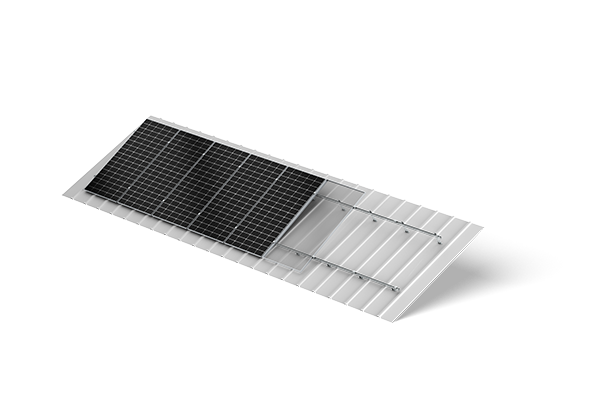Cost Analysis: Installing Solar Panels on Metal Roofs vs. Other Roofing Types
August 04, 2025
As more homeowners consider solar energy, the type of roofing can significantly influence the cost and efficiency of solar panel installations. This article will explore the cost implications of installing solar panel mounts for shingle roof compared to other roofing types, particularly focusing on the use of solar panel mounts for shingle roofs.

When examining the costs associated with solar panel installations, it's crucial to differentiate between the initial setup expenses for various roofing types. Metal roofs are often more expensive upfront compared to shingle roofs. However, they offer unique advantages that can affect long-term costs.
For shingle roofs, the installation typically requires solar panel mounts designed specifically for their structure. These mounts may involve more extensive roof modifications, leading to higher labor costs. In contrast, the installation of solar panels on metal roofs often utilizes simpler mounting systems that can be more straightforward to install, potentially reducing labor costs in the long run.
One of the key considerations in cost analysis is the durability of the roofing materials. Metal roofs tend to have a longer lifespan than shingle roofs, which can require replacement every 15 to 30 years depending on wear and tear. This durability translates into lower long-term maintenance costs when installing solar panels on metal roofs.
On the other hand, solar panel mounts for shingle roofs may need to be replaced or adjusted more frequently due to the wear on the roofing material. This ongoing maintenance can accumulate costs over time, making metal roofs a more economically sound choice for solar panel installations.
The efficiency of solar panels can also be influenced by the type of roof. Metal roofs provide a more reflective surface, which can help improve the overall efficiency of solar panels. In contrast, shingle roofs may absorb more heat, potentially impacting solar panel performance.
Using an adjustable tilt system for solar panels can further enhance efficiency, especially on metal roofs. This system accommodates various sunlight angles, optimizing sunlight exposure. The high efficiency of this angled design, combined with easy installation due to highly pre-assembled parts, can result in significant savings for homeowners.
In conclusion, while the initial costs of installing solar panels on metal roofs may be higher compared to shingle roofs, the long-term benefits in maintenance, durability, and efficiency can lead to overall cost savings. Evaluating these factors is essential for homeowners considering solar energy options.
At Antaisolar, we are dedicated to advancing the development and application of new energy through technological innovation. Our comprehensive range of solar solutions, including adjustable tilt systems, ensures that homeowners have access to efficient and cost-effective options for their roofing needs.

Initial Installation Costs
When examining the costs associated with solar panel installations, it's crucial to differentiate between the initial setup expenses for various roofing types. Metal roofs are often more expensive upfront compared to shingle roofs. However, they offer unique advantages that can affect long-term costs.
For shingle roofs, the installation typically requires solar panel mounts designed specifically for their structure. These mounts may involve more extensive roof modifications, leading to higher labor costs. In contrast, the installation of solar panels on metal roofs often utilizes simpler mounting systems that can be more straightforward to install, potentially reducing labor costs in the long run.
Long-Term Maintenance and Durability
One of the key considerations in cost analysis is the durability of the roofing materials. Metal roofs tend to have a longer lifespan than shingle roofs, which can require replacement every 15 to 30 years depending on wear and tear. This durability translates into lower long-term maintenance costs when installing solar panels on metal roofs.
On the other hand, solar panel mounts for shingle roofs may need to be replaced or adjusted more frequently due to the wear on the roofing material. This ongoing maintenance can accumulate costs over time, making metal roofs a more economically sound choice for solar panel installations.
Energy Efficiency and Performance
The efficiency of solar panels can also be influenced by the type of roof. Metal roofs provide a more reflective surface, which can help improve the overall efficiency of solar panels. In contrast, shingle roofs may absorb more heat, potentially impacting solar panel performance.
Using an adjustable tilt system for solar panels can further enhance efficiency, especially on metal roofs. This system accommodates various sunlight angles, optimizing sunlight exposure. The high efficiency of this angled design, combined with easy installation due to highly pre-assembled parts, can result in significant savings for homeowners.
In conclusion, while the initial costs of installing solar panels on metal roofs may be higher compared to shingle roofs, the long-term benefits in maintenance, durability, and efficiency can lead to overall cost savings. Evaluating these factors is essential for homeowners considering solar energy options.
At Antaisolar, we are dedicated to advancing the development and application of new energy through technological innovation. Our comprehensive range of solar solutions, including adjustable tilt systems, ensures that homeowners have access to efficient and cost-effective options for their roofing needs.
end
